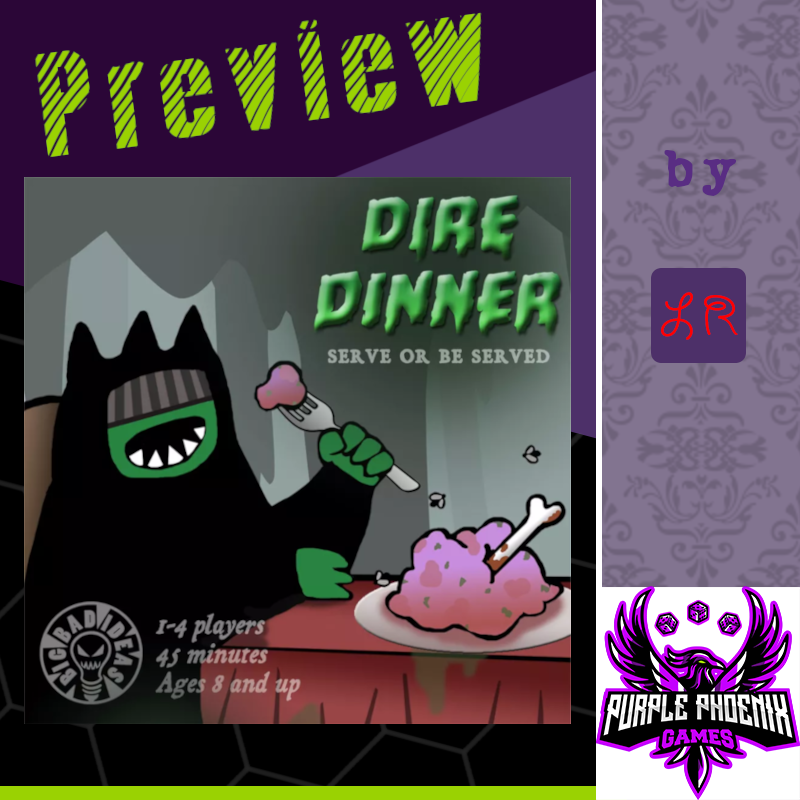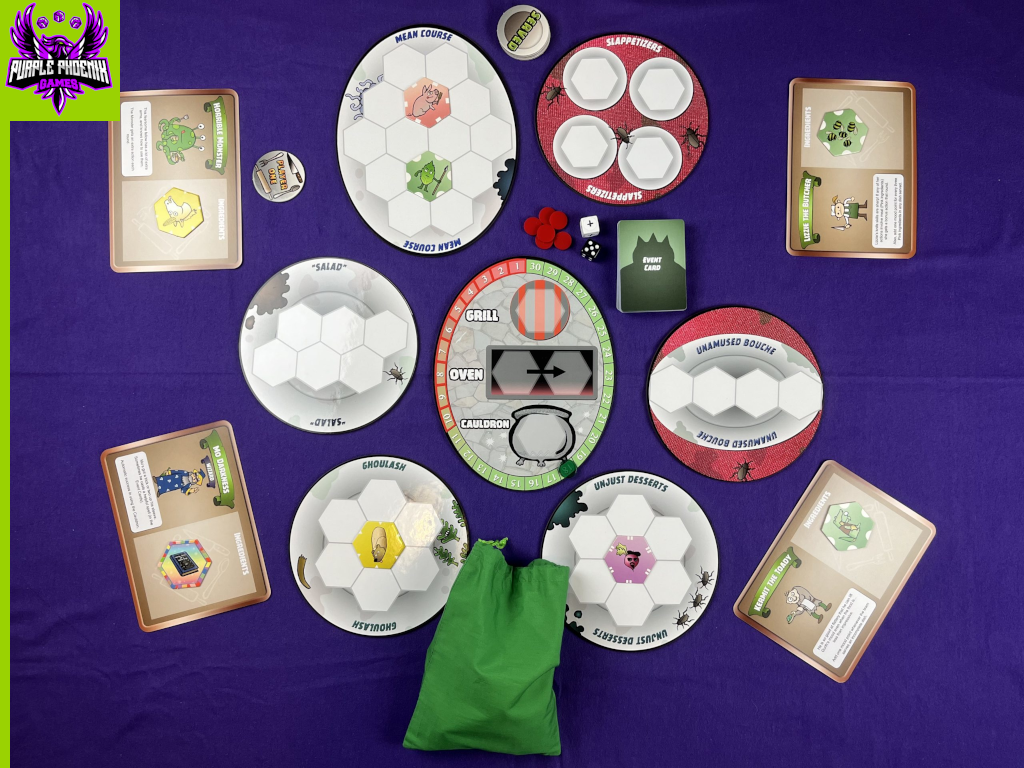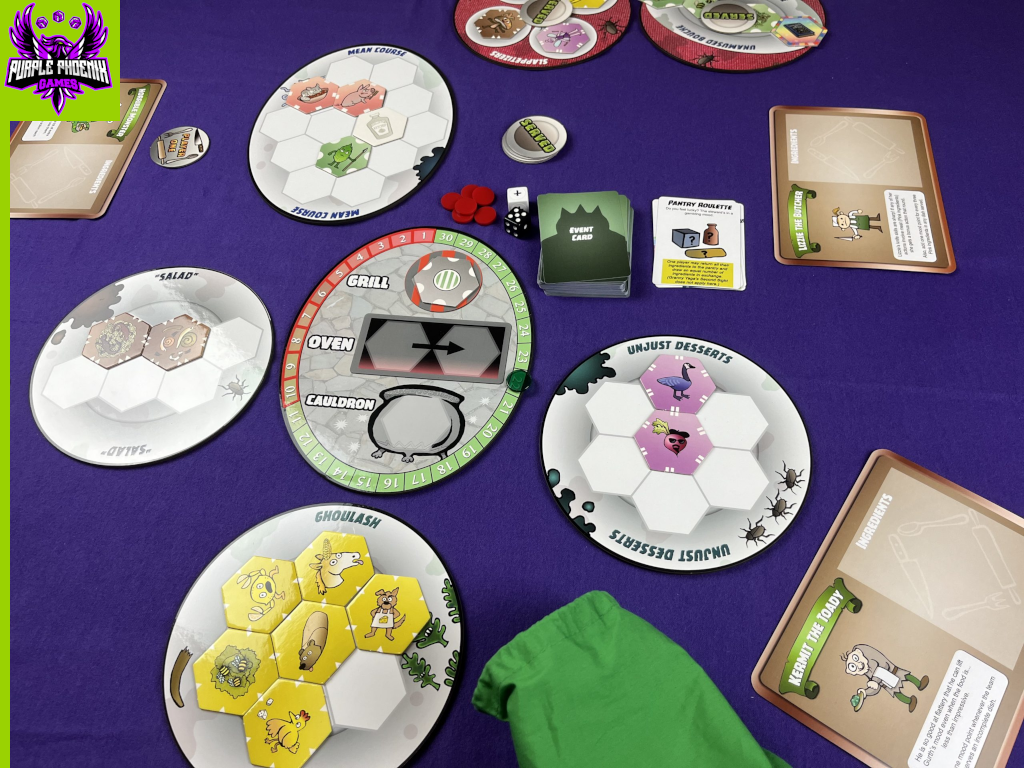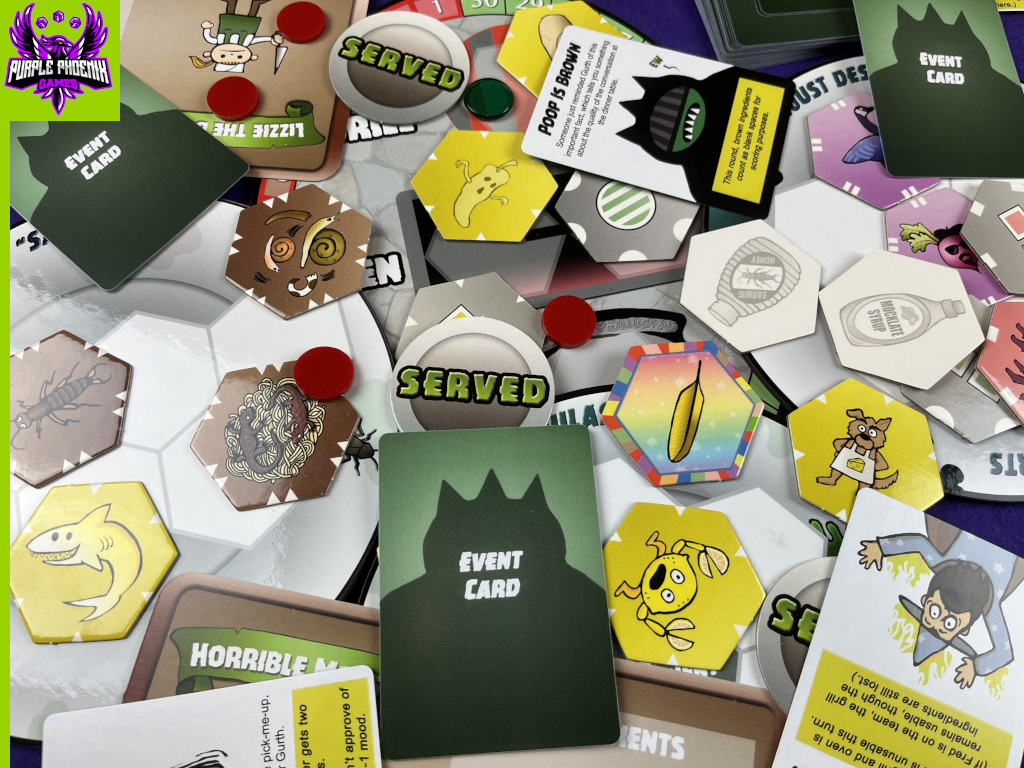
According to Merriam-Webster, the word ‘hangry’ means irritable or angry because of hunger. And I’ll be the first to admit that I get hangry quite easily. And my patience can wear pretty pretty thin when I am hangry. So I can absolutely relate to Gurth the Odious in this new game from Big Bad Ideas LLC. Gurth is definitely hangry and it’s up to you and your rag-tag group of minions to serve him up a six-course meal that will satisfy his hunger! But beware – if he doesn’t enjoy the meal you serve, he may just try to eat YOU in the end.
| Dire Dinner (2023) | Big Bad Ideas LLC |
| 1-4 players | 45-90 minutes |
| Ages 8+ | BGG Weight – Not yet available |
Disclaimer: We were provided a prototype copy of Dire Dinner for the purposes of this preview. What you see pictured below will differ from the final production copies. -L
Dire Dinner is a cooperative game in which players take on the roles of minions who are creating and cooking a six-course meal to satiate the hunger of the monster boss Gurth. You must find ingredients, cook them up, and plate them in an appealing way to help improve Gurth’s hunger and mood. Make too many mistakes, or miss the mark on a dish, and Gurth gets more irate. Nail the components of a dish, and he will get marginally less hangry. See if you can survive until the end of dinner, and hope that he’s satisfied!
To setup for a game, place the six Plates, Kitchen board, and Round Tracker in the middle of the table. Give each player a Character Card and randomly select a 1st Player. Draw 4 Ingredients (tiles) from the Pantry (bag of tiles) and place them on the ‘Core Ingredient’ spaces of each dish, as described in the rulebook. Each player receives one random Ingredient and places it in their Prep Area (on their Character Card). Set tokens on the Round Tracker and Mood Scale to start the game, and shuffle the deck of Event cards. Tie up those aprons, because it’s time to get cookin’! Setup should look like the picture below.

Played over a series of rounds, players will be performing Actions and working together to plate up the best dishes possible. To start every round, an Event card is drawn. These cards bring new effects into play that could alter how the round is played. Once the Event card is resolved the round properly begins with the 1st Player. On your turn, you can perform up to 3 Actions. The Actions are: Draw an Ingredient from the Pantry, Place/Manipulate/Remove an Ingredient from the Kitchen Board, Place an Ingredient onto a Plate, Move an Ingredient from one Plate to another, and Give/Take an Ingredient from another player.
Many of the Ingredients in the game need to be cooked before they can be plated, and that’s where the Kitchen Board comes into play. When you have one of those Ingredients, you can spend an Action to place it onto the corresponding section of the Kitchen Board. The Grill takes 2 Actions – place Ingredient on the Grill, and remove it from the Grill to a Plate. The Oven takes 3 Actions – place Ingredient in Oven, advance Ingredient in Oven, and remove it from the Oven to a Plate. There is also a Cauldron on the Kitchen Board with special rules of it’s own, but I’ll leave that for you to discover. Strategize wisely on how to utilize your Actions, and synergize with your teammates to see if you can tag-team the Kitchen Board! Each player’s Character also has a unique ability to be used throughout the game, and these powers help elevate the strategy each round.
When plating Ingredients, there is a single placement restriction – each Ingredient must be placed next to another Ingredient of the same color. Pretty simple rule, but more complicated to follow than you’d think! Some Ingredients are Rainbow-colored, and they count as Wild when it comes to placement. Some Ingredients are White, and they also count as Wild, but using them will result in negative points when presenting a dish! At any point during a round, players may choose to place Spice Tokens on a Plate as a free action. Spices will either enhance or harm a dish when it comes time to score the Plate.
After all players have taken their turns, the round ends. At the end of the first round, nothing special really happens, but at the end of every subsequent round, players are required to present a Plate to Gurth. When you present a Plate, it will either improve Gurth’s mood, or it will make him angrier. If you manage to completely fill a Plate with Ingredients, you will earn bonus Mood points. But every Plate with empty spaces or White tiles on it will earn you negative points. For each Spice Token on a dish, roll the Spice Die and add that to your score accordingly. Count up your score for the Plate you chose to serve this round and apply the points on the Mood Scale. If the Mood Scale reaches 30, Gurth is satisfied and you win! If the Mood Scale reaches 0, you lose and are devoured. If neither of those outcomes has occurred, move the served Plate out of the way, and begin a new round. If you’re able to survive 7 rounds (serving all 6 Plates) check to see where you land on the Mood Scale. If Gurth’s mood is at 11 or higher, you manage to survive. But anything lower and you lose.

Dire Dinner may sound a little complicated, but it’s actually pretty straightforward. You draw Ingredients and place them on Plates. Some Ingredients take an extra step or two, but the main gist is nice and simple. So how do I like the gameplay overall? I think it’s pretty decent! I really like the cooperative aspect, as it gets everyone engaged and working together. All players still get their own Actions each round, so nobody can really ‘quarterback’ the group, which can sometimes be an issue with cooperative games. It’s fun to be able to interact with my fellow gamers and openly talk strategy, when in competitive games you have to keep everything to yourself. The pace of gameplay is pretty fast, and the rules are relatively easy to learn and teach. All in all, thumbs up from me!
The biggest issue I had with the game had nothing to do with the gameplay, but rather the rulebook. As mentioned earlier, this is a prototype copy of the game, and I’m sure the rules are still being edited and tweaked. But as they are now, there were some instances of ambiguity that left us scratching our heads more than once. Like the placement rule states that when plating Ingredients, they must touch an Ingredient of the same color. But the Mean Course dish has 2 Core Ingredients, that during our plays, were always each a different color. So that stopped us from being able to complete that Plate, as playing an Ingredient that matched one of the colors also touched an Ingredient of another color. We weren’t quite sure how we were supposed to rule that. A little more clarity on that specific plate would have been nice. But like I said, with some editing and final tweaks to the rules, I’m sure it’ll help fix some of those little issues.
When it comes to components, again I’m going off of a prototype copy. That being said, the Plates and Kitchen board are pretty neat. I like that they are each their own separate component, as it makes it feel more like actual plates. The Ingredient tiles are also nice and chunky, and the Character Cards are large and clear. The artwork is quirky and unique, and is cute to match the overall theme of the game. Even from a prototype, the components look good to me, so I look forward to seeing the finished product!
Dire Dinner is a fun and unique game that gets players cooperating to achieve a common end-game goal – survival! The theme is cute and funny, the gameplay is fast to pick up, and the components are decent quality. With some work on the rulebook, I think this game can have some great potential! If this has piqued your interest, keep an eye out because Dire Dinner hits Kickstarter on February 21st! Put your culinary skills to the test – your life depends on it!

